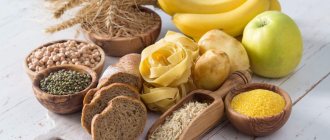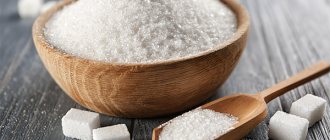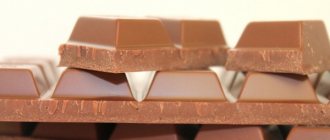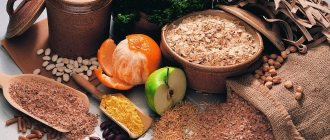The human body is a complex mechanism, and sugar is a kind of “fuel” for its normal functioning . There are so many rumors and myths about sugar that it is very difficult to figure out what is true and what is fiction or exaggeration. Let's try to do this together.
In everyday life, sugar is commonly called sucrose, a disaccharide common in nature. Sucrose is found in fruits and berries, but the largest amount is contained in sugar cane and sugar beets. It is these plants that are the basis of industrial sugar production.
When we say the word “sugar,” we usually imagine a white, free-flowing product. Few people think about the fact that sugar comes in a variety of forms.
Calorie content of sugar
Sugar comes in different types:
- reed;
- beet;
- palm;
- maple.
Depending on the cleaning method chosen, it can be yellow or white. All varieties have almost the same number of calories, the difference is only a few units. In the CIS countries, the beetroot type of sweetener predominates.
We recommend reading the article about the dangers of sugar for the human body.
If we take into account the volume of 100 g of sugar, the calorie content will be 399 kilocalories. 99% of the sugar composition is made up of di- and monosaccharides, which make the product so high in calories. Only 1% is allocated to water, iron, sodium and calcium.
The maple variety has a lower calorie content - 354 kcal. This species is widespread in Canada, from where it is exported to other countries. It is made from maple buds.
Below is a table with the number of calories and BJU of sugar:
| Calories, kcal: | 398 |
| Proteins, g: | 0,0 |
| Fats, g: | 0,0 |
| Carbohydrates, g: | 99,7 |
How is refined sugar made?
The manufacturing process begins with the collection of raw materials. If it is beets, they are raked into windrows and then shipped to the factory, where they are washed and distributed into cleaning bins, filled with lime mortar. The production of refined sugar at the first stage is carried out according to the same algorithm as for the unrefined product.
After bacteriological purification, the raw materials are washed, crushed, sugar syrup is extracted in special installations, and then primary filtration is carried out, passing through a porous septum with perlite. The liquid is evaporated and crystallization is carried out in a vacuum unit. The resulting mixture is sucrose with molasses (molasses). It is placed in a centrifuge to separate into fractions.
How to make refined sugar from unrefined raw sugar:
- Clerification is carried out - dissolved in water heated to a temperature of +85°C, and syrup of 73% concentration is boiled. Re-filter using mineral fillers - gravel or perlite.
- The purified substance is sent to adsorption units. At the first stage of purification, the syrup is decolorized, and at the second stage, the sugar-containing rinse is separated. The chemical raw material used during the process is activated carbon. It is separated during re-cleaning.
- The purified syrup is concentrated in vacuum units. Crystallization temperature - +78°C, process duration - 70–85 minutes.
- Intermediate raw materials (mascuite) are sent to crystallizers equipped with mixers, then transferred to centrifuges.
If you plan to produce granulated sugar, the refined sugar porridge is dried to a moisture content of 0.1% and sent for pre-sale preparation - packaging.
If pressing is necessary, the massecuite is blanked and sent to carousel units, where briquettes are obtained. They are dried to the required moisture content - 0.2-0.3%, then split or cut into pieces of the required size.
Refined sugar is produced in the form of pressed instant sugar. The quality of the final product depends on the degree of pressing.
Note! Refined cane sugar is produced using the same algorithm. Features - the clarification process is eliminated.
When making powdered sugar at home, regular refined sugar is ground in a coffee grinder or using a blender. In factory conditions, refined powder is obtained not from granulated sugar, but from waste from pressing and cutting briquettes. The crystals are crushed in a mill, starch is added - usually potato starch (3% of the total volume). If this is not done, the product cakes during storage and crystallizes. Powder moisture content is 0.2%. The difference between refined powder and sand is its increased nutritional value.
How many calories are in a spoonful of sugar?
Carbohydrates in the form of white powder are often used in cooking and canning, both in the preparation of sweet dishes and desserts, and in basic treats. When creating baked goods, the amount of this ingredient is usually measured in glasses or spoons. Therefore, it will be useful to know how many calories are in 1 teaspoon of sugar, in a tablespoon or in one glass to determine the calorie content of the entire dish as a whole.
Video
A standard tablespoon contains 20 g of granulated sugar. If you pour it in a heap, then 25 g. One gram contains 3.99 kcal. Using simple mathematical calculations, you can find out that a standard-sized level tablespoon contains 80 calories, and a heaped spoon contains 100 calories, respectively.
What is the norm for sugar consumption?
Publication date: December 24, 2020.
Many people are interested in the question, how many calories are in a teaspoon of sugar?
First you need to understand what characterizes sugar as a food product.
The human body is a complex system. Sugar is an excellent fuel for such a system.
There are three types of carbohydrates in plants. Sugar can be classified as one of these types.
This product can be made from pumpkin, cane, corn or grapes.
The question arises, why can sugar, with all its benefits, be called “sweet death”?
It turns out that sugar can provide the body not only with useful calories, but also completely empty calories.
The fact is that sugar contains 67% simple carbohydrates. Sugar contains 4% copper, 1% iron, and 2% riboflavin. These elements are not vital vitamins, that is, sugar has practically no necessary nutrients for the human body.
One teaspoon of sugar contains about 15 calories. If you count the calories in cups that a person drinks per day, then 30-35 calories will be consumed at a time (with 2-3 tablespoons of sugar).
Do you want to cover long distances at a fast pace? Find out how to breathe properly when running long distances.
This news is about how to swim crawl.
Many people are also interested in the question: how many calories are in compressed sugar? The calorie content of pressed sugar is at the level of ten calories, which is even less compared to granulated sugar.
How many calories are in a teaspoon of sugar?
This information will be useful to those people who cannot do without drinking tea every day, and to coffee lovers. Usually when creating a balanced or dietary menu, many people forget to take into account how many calories are in the granulated sugar that they add to their hot drink. Therefore, they usually exceed the daily sugar requirement and their weight loss process does not bring results.
Please note: A standard size teaspoon holds 5-7 g of loose powder. This amounts to 20-35 calories.
Which sugar is the healthiest?
Despite popular misconception, the differences between different types of sugar are minimal. The number of kilocalories per gram of sugar and the glycemic index are not affected by the shade of sugar and the plant from which it is extracted (cane or beets). There is only one difference: the slight aftertaste that brown sugar has.
Many people believe that it is healthier to replace sugar with honey. However, it is not. Honey is 80-85% sugar, while brown sugar is 98% glucose. Naturally, neither one nor the other product, if consumed in moderation, can bring any health benefits.
Brown sugar calories
In recent years, there has been a lot of talk about brown cane sugar and its great benefits. Some even completely replace the standard white variety with the brown one, as they are confident that its energy value is much lower than that of the usual one.
Indeed, the calorie content of this product will differ from that of the white species. But 100 grams contains 378 calories, and the difference actually turns out to be insignificant. Therefore, if you replace one variety with another, there will be no significant difference in weight loss due to the same number of calories.
Video
Is it possible to give up sugar?
The popular belief that nerve tissue requires glucose to function properly is a misconception. A much better option for all body tissues are complex carbohydrates, which come from cereals and plant foods.
For thousands of years, people managed without large amounts of sugar in their diet: mass production of this product began only in the century before last. Well, in the last half century, sugar consumption has increased several dozen times. Perhaps this is precisely what explains the catastrophic increase in the number of people suffering from excess weight.
How many calories are in a spoonful of cane sugar?
Likewise, if you measure the calorie content of cane powder in tablespoon or teaspoon volumes, the numbers will be approximately the same as for white. There are 75 kcal per 20 g tablespoon, and 19-26 kcal per teaspoon. Reed has approximately the same ratio of BPJU, but a richer mineral composition than white.
Cane product should under no circumstances be considered dietary and should not be used in the fight against obesity. Excessive consumption of cane sand and its calories will cause the same harm to the body as the use of its analogues.
We recommend reading the article on how to give up sweets.
Natural sugar substitutes
People who care about their health are often interested in what to replace sugar with a healthy diet? Dried fruits are an excellent product for dieters. They are natural, safe for health and even healthy. Any dried fruits are suitable for daily consumption: dried apricots, raisins, prunes, pears, etc. But do not lean too heavily on them. 100 g per day is quite enough. In such quantities, dried fruits will not cause harm.
When purchasing dried fruits, you should pay attention to their appearance. Very often, merchants process them to attract the attention of buyers. It is unlikely that such dried fruits can replace sugar, since after processing they not only lose all their beneficial properties, but can also become harmful to health.
A natural sweetener is honey. It is added to baked goods, drinks and desserts. Honey contains many vitamins and minerals. It helps in the fight against various diseases, for example, it is indispensable for colds. But when consuming honey, you should remember that it is much sweeter than sugar: for example, a teaspoon of bee sweetness is equal to 4 teaspoons of white sweetness.
Those who do not like honey can use stevia, a honey herb. It is saturated with stevioside. This substance is 200 times sweeter than sugar. It’s hard to imagine how much sweetness a tablespoon of stevia contains. But this herb contains too few calories. It has a beneficial effect on the digestive system.
Although nutritionists consider this product harmful, they nevertheless even offer a mono-diet with it. The sugar diet is not about delicious croissants, sweets or layer cakes. Solid food should be completely excluded from the diet, even if it contains very few calories. You can only drink sweet liquids and mineral water.
The sugar diet can be carried out only for 1-2 days, maximum - 3. During this time, you can drink weak tea - green or black, decoctions of raspberry leaves, cherries, cherries, currants. Rosehip is especially good, as it saturates the body with vitamin C. You can drink 5-6 glasses of liquid per day. You can add 30 g of sugar to each glass. The sugar diet also involves drinking mineral water. During the entire period of the diet, you should drink 2 liters of mineral water.
Calorie content of sweeteners
Some sweet lovers who cannot completely give up sugar prefer to choose sweeteners. There are varieties of natural and synthetic origin. Natural ones include fructose, sorbitol, xylitol.
| Sweetener | Energy value |
| fructose | 375 kcal |
| sorbitol | 354 calories |
| xylitol | 367 calories |
According to the table, the nutritional value of sweeteners is almost the same as that of the natural product. The group of synthetic sweeteners includes saccharin, aspartame, sucralose, sodium cyclamate.
Video
The calorie content of such substances is zero. Therefore, people choose such products in order to fight excess weight. Plus, sweeteners do not cause destructive harm to tooth enamel and do not provoke the development of caries.
Important: Despite the fact that they are zero calorie, they promote overeating. The thing is that when eating them, the human body does not feel full.
Therefore, he eats much more products with synthetic sweeteners. Another disadvantage of such products is that they contain harmful substances that provoke the development of cancer, allergies, kidney failure and many other side effects.
Sugar: in what form and how much can you eat?
Sugar, like carbohydrates in general, is one of the most controversial foods. If you eat too little sugar, you won't have the energy to exercise. Too much sugar and you get fat. In fact, deciding how much and when to eat carbohydrates is not that difficult. To do this, it is enough to follow the recommendations given by doctors and scientists.
Sweet Science
Sugars (sucrose and fructose) are what are called “simple” carbohydrates because they are made up of a single sugar molecule. A glass of Pepsi contains 17 grams of carbohydrates and 17 grams of sugar. This means that every carbohydrate comes from sugar. 100 grams of oatmeal contains 65 g of carbohydrates and only 4 g of sugar. Almost all of the carbohydrates in oatmeal, as in bread, rice and corn, are made up of long chains of sugar molecules called "complex" carbohydrates.
However, the terms “complex” and “simple” are important only for science. From a consumer perspective, it makes more sense to look at carbohydrates as “unprocessed” and “processed.” The first are whole sugar-containing foods - fruits, vegetables, juices, grains and legumes, which retain natural water, fiber, vitamins and minerals.
“Processed” carbohydrates include white bread, soda, candy, crackers, cookies, and virtually any commercial product labeled “fat-free.” They are often devoid of their beneficial properties and are filled with “empty calories” - simple sugars. For example, 1 g of crackers will contain 4 calories, while 1 g of oranges contains about 0.2 calories, because the bulk of its mass is water and fiber.
Glycemic index
The glycemic index (GI) measures how quickly certain foods are converted into glucose (a form of sugar) in the blood. The GI is a valuable tool for controlling sugar intake and limiting its negative effects. While high GI foods can cause your blood sugar to spike quickly and then drop just as quickly, low GI foods slowly raise your blood sugar levels, providing consistent, stable energy levels over an extended period of time.
Several factors influence the glycemic index of a food, including the presence of protein, fiber and fat. Pure processed sugars score the highest (i.e. worst for us) index values. For example, instant rice has an index of 90 (with a maximum of 100), while brown rice, rich in fiber and vitamins, has a GI of 55.
Recent research from the Harvard School of Public Health has shown that diets loaded with high-GI foods lead to an increased risk of type 2 diabetes, coronary heart disease and obesity. The World Health Organization even insists that the GI be stated directly on food labels. And in some countries such designations are already appearing on packaging.
It's about insulin
Although sugar contains fewer calories per gram than fat, sugar is the largest contributor to body fat storage.
This effect is largely due to a hormone called insulin. The more refined sugar you eat, the more insulin is released from the pancreas. The main role of insulin is to return blood sugar levels to normal. However, when your blood sugar spikes, which happens when you eat high GI foods, your body pumps huge amounts of insulin into your bloodstream. This leads to excess sugar, a sharp decrease in sugar levels and causes appetite, leading to a vicious cycle of overeating. Sugar is often even called a drug rather than a nutrient because it provokes hunger even more than it satisfies.
Overeating is not the only danger. Years of eating processed foods and constant insulin spikes can undermine the pancreas' ability to produce insulin, significantly increasing the risk of diabetes. When the body becomes so accustomed to insulin spikes that the hormone loses its ability to lower blood sugar levels, another condition known as insulin resistance develops.
Additionally, a recent study published in the British Medical Journal found that men with elevated blood sugar levels have a higher mortality rate from cardiovascular disease.
Not only harm
Considering all this, it can be assumed that sugar or even carbohydrates in general are a harmful product. However, they do have their benefits, especially if you lead an active lifestyle.
In moderation, carbohydrates are an important part of the diet. Carbohydrates are used by the body as fuel and stored in the liver and muscles in the form of glycogen. The problem is that this “warehouse” is limited, which means that everything excess turns into fat.
Any type of carbohydrate consumed during exercise improves endurance, especially if the athlete trains for a long period of time during which glycogen stores have time to deplete. Moreover, there is evidence that carbohydrates also improve performance during intense exercise that lasts less than 20 minutes.
Each person reacts to carbohydrates individually, but regardless of the level of metabolism, it is worth following a few simple rules:
1. Limit your intake of refined carbohydrates
Being devoid of nutrients and fiber, refined carbohydrates contain a lot of calories in a small amount. As a result, they are weak appetite quenchers and easy to eat too much of. A maximum of 15%-20% of total carbohydrates should come from refined sugars. That's no more than 250 calories for a 2,500 calorie per day menu.
Unrefined carbohydrates are found in fruits, some vegetables and other whole foods. These should make up the bulk of the carbohydrates you eat every day. Fruits and vegetables contain fiber, water and vitamins, making it almost impossible to eat too much of them. For example, the average person needs to eat about 50 oranges or 10 kg of cabbage per day just to maintain their weight.
2. Use sugar when needed
Despite their disadvantages, simple carbohydrates are essential for heavy training to quickly replenish glycogen stores. If you don't have enough glucose in your body, you will feel sluggish during exercise and will not be able to exercise effectively. In addition, carbohydrates are necessary for burning fat. With their constant shortage, the body will try to slow down metabolism, saving energy, and will burn fat more slowly.
3. Don't overdo it
Just because you're training hard, you shouldn't eat a bowl of sugary cereal for breakfast and wash it down with cola. Your body still has limited glycogen storage capacity, and excess sugar will be stored as fat. This means choosing unrefined sources of sugar such as fruits, vegetables and whole grains, while avoiding candy, soda and other processed foods.
4. Choose the right time
A study in the American Journal of Physiology found that consuming carbohydrates immediately before exercise suppressed the fat-burning effects of cardio training. If you run in the morning, do it before breakfast. If you're exercising in the afternoon, focus on low-glycemic index foods and eat them at least two hours before your run.
5. Eat lunch before dessert.
The glycemic index of a food depends on what you already have in your stomach or what you eat with it. Avoid consuming high GI foods separately. If you receive a box of chocolates as a gift, treat yourself to them without fanaticism and only after a healthy meal.
6. Don't rely on sugar substitutes
Only lazy people haven’t written about the dangers of artificial sweeteners. At the same time, scientists from the University of Southampton found that sweeteners do not increase the tendency to snack, do not affect blood sugar or insulin levels, and may even help some people lose weight by reducing their sugar intake. On the other hand, authoritative and respected members of the medical community actively oppose aspartame and urge their patients to give it up. So here, as in all other cases, the best way is moderation.
Natural sugar
Below is a list of some common sources of natural sugars that are friendlier to the body than regular cane or beet sugar. However, even though many of these sugars are unrefined, they still contain a ton of calories and can be harmful if consumed in large quantities. In addition, such sugar is usually not cheap.
Date Sugar : It is made from dry dates and is rich in minerals and fiber.
Fruit juice : Absorbed relatively slowly by the body, causing a moderate increase in insulin levels.
Honey: Good for increasing energy, but contains more calories and negatively affects dental health. Use in moderation.
Maple syrup : A sweetener that is extracted from the maple tree. Rich in minerals, potassium and calcium.
Brown Sugar : A sweetener derived from sugar cane. It is almost no different from white sugar, the only difference is in the larger amount of minerals and vitamins.
Sucanat: A little-known product made from sugar cane. Similar to white sugar, but contains vitamins and minerals that the latter does not contain.
Artificial sweeteners
The following sugars can be found in many modern foods. You should stay away from them.
Molasses: The liquid that remains after the sucrose is removed from beet juice or sugar cane.
Corn syrup: Found in dozens of foods, from ice cream to canned fruit. Used to increase viscosity, improve texture and color.
Glucose (dextrose) : industrially it is obtained by hydrolysis of starch and cellulose. Used in the confectionery industry.
Granulated sugar : granulated sugar. There are a large number of types of granulated sugar, differing primarily in crystal size. Most of them are used only in professional confectionery and culinary fields.
Fructose Corn Syrup : Made by adding enzymes to corn starch. Commonly used as a substitute for sugar in processed foods in the United States—primarily soft drinks, ice cream, and frozen desserts.
Invert sugar : An equal mixture of glucose and sucrose found in carbonated drinks.
Aspartame: harm or benefit?
Since 1981, when aspartame was approved by the US Food and Drug Administration (FDA), the drug has been repeatedly attacked in the media for various reasons. However, among opponents of this substance there is no consensus on which component is toxic: first it was aspartic acid, then methanol, phenylalanine, and now it is diketopiperazine (DCP).
Phenylalanine and aspartic acid are amino acids found in dietary proteins, and most methanol in the body comes from digesting fresh fruits and vegetables, not aspartame. As for PrEP, according to a study published in the journal Food Chemistry and Toxicology, a record 12.5 g of aspartame taken experimentally by six volunteers did not cause any side effects.
As a result, aspartame is still considered safe by the FDA, the American Dietetic Association, and scientists who have tested it on humans multiple times at universities around the world. However, public concerns remain. Possibly due to reports of aspartame allergies. One in every 16,591 people actually has the condition, according to the journal Modern Nutrition in Health and Disease. It's called phenylketonuria - and it occurs when the body cannot properly metabolize phenylalanine, one of the amino acids found in aspartame.
Read us on Twitter, Facebook, VKontakte or Telegram. Useful tips and interesting facts about health every day.
Comments
comment(s)
Daily sugar intake for women and men
In accordance with WHO standards, the percentage of calories that enter the body with sugar should be no more than 10% of the total. For men, this sweetener norm is up to 9 teaspoons, for women – 6.
But this number needs to take into account more than just the number of teaspoons of sweetener that have been added to drinks or certain dishes. You need to count the amount of sweetener in all food eaten per day. For example, a glass of a sweet carbonated drink with some sweets can pay for the entire daily requirement in one go.
This is interesting! American researchers were able to calculate that the average US resident eats 190 g of sweetener daily. In Russia, the statistics are different, where the number is 100 g of granulated sugar per day per average resident.
Sugar – benefit or “white death”?
Scientists have calculated that if you regularly eat granulated sugar in large quantities, and even add all kinds of sweets to it, then no one is immune from obesity. Therefore, in order to maintain your health, it is better to give up sugar or reduce its consumption to a minimum.
In general, does crystalline sugar contain anything useful? The majority are carbohydrates, which are quickly and easily absorbed by the human body. Metabolic processes are activated, and incoming sucrose quickly turns into glucose.
On the one hand, this is certainly good, because we need energy every day to perform even the simplest tasks. But if the number of calories consumed significantly exceeds consumption, excess weight appears, which is sometimes problematic to get rid of.
Granulated sugar, regardless of the variety, does not contain any vitamins, beneficial micro- and macroelements, or mineral compounds. If we talk from the point of view of chemical composition, then this is pure sucrose, which in turn is divided into fructose and glucose.
Of course, sugar gives us strength and charges the body with energy. In addition, eating sweets can activate your brain and improve your mood. They also say that sweet foods are responsible for the production of so-called happiness hormones.
Important! If you can't completely give up sugar, then at least minimize your daily consumption.
As for the harm from this product, it is obvious. We consume granulated sugar every day, not only in its pure form. This additive is found in many foods, mainly in desserts and sweets. Therefore, without knowing it, you can eat sugar in excess of the norm every day. The result is excess body weight or diabetes.
But these are not all negative consequences. Granulated sugar in any form has a destructive effect on tooth enamel. It can cause the development of caries and other oral diseases.
Still, don’t forget about diabetes. Some people are convinced that this is a hoax. In fact, excessive sugar consumption increases blood glucose levels. If energy is not expended, then as a result, glucose will begin to suppress insulin production. It is for this reason that diabetes mellitus occurs.
Benefits and harms
Sugar powder is an easily digestible carbohydrate with a high calorie content that charges the human body with energy. Sucrose is broken down into glucose and fructose. Glucose becomes a participant in the synthesis of sulfuric acid, activates internal organs, promotes the production of insulin and hormones of happiness and joy. If we consider the biological nutritional value and calorie content of white carbohydrate, then its fat and protein content is zero. Excessive sugar consumption can lead to obesity, the development of caries and other dental problems, and calcium and mineral deficiency in the body.
Is all sugar “bad”?
Sugar itself is not an absolute evil, since it gives the cells of our body energy. When doctors talk about reducing sugar intake, they are primarily talking about added sugar, which is added during the cooking process to add a sweet taste to a food, dish or drink.
Added sugars are different from natural sugars found in fruits or milk, for example. Natural sugars come into the body along with vitamins, minerals, dietary fiber and nutrients that help offset some of the negative aspects. For example, the fiber in fruits inhibits the rapid absorption of sugars and has less of an effect on the increase in blood glucose.
Composition and calorie content of refined sugar
Despite the absence of fats, a large amount of this type of sweetness in the diet against the background of low vital activity leads to weight gain.
The calorie content of refined sugar from sugar beets is 400 kcal per 100 g, of which:
- Proteins - 0 g;
- Fats - 0 g;
- Carbohydrates - 99.9 g;
- Water - 0.1 g.
The nutritional value of a product made from sugar cane is 397-399 kcal per 100 g.
When compiling a daily diet, this difference can be ignored. The higher price is not explained by the increased content of nutrients, but by delivery costs - sugar cane is not grown on an industrial scale in the former CIS.
Despite the two-stage purification, a small amount of vitamins and minerals remains in refined sugar. There are slightly more of them in a product made from cane:
- Retinol equivalent
- supports visual function and has antioxidant effects. - Biotin
- stimulates the activity of B vitamins, prevents early gray hair, improves the quality of nails and hair. - Tocopherol equivalent
- increases immunity, reduces the likelihood of malignancy of neoplasms in the excretory systems. - Phosphorus
- distributes energy throughout the body, strengthens bone and muscle tissue and helps absorb iodine and zinc. - Chlorine
- normalizes digestion and water-electrolyte balance, prevents fluid loss. - Sulfur
- stimulates the production of bile and normalizes blood sugar levels.
No matter what form refined sugar is produced in - pieces, sand or powder, the chemical composition is similar. This is achieved by thorough cleaning and removal of molasses.










